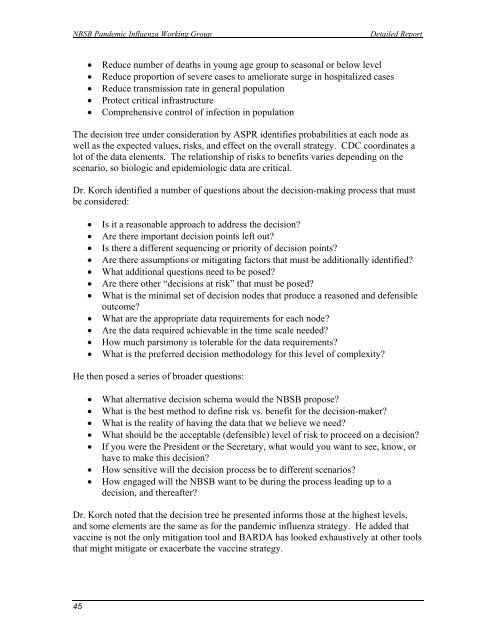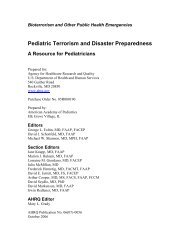H1N1 COUNTERMEASURES STRATEGY AND ... - PHE Home
H1N1 COUNTERMEASURES STRATEGY AND ... - PHE Home
H1N1 COUNTERMEASURES STRATEGY AND ... - PHE Home
You also want an ePaper? Increase the reach of your titles
YUMPU automatically turns print PDFs into web optimized ePapers that Google loves.
NBSB Pandemic Influenza Working Group<br />
Detailed Report<br />
<br />
<br />
<br />
<br />
<br />
Reduce number of deaths in young age group to seasonal or below level<br />
Reduce proportion of severe cases to ameliorate surge in hospitalized cases<br />
Reduce transmission rate in general population<br />
Protect critical infrastructure<br />
Comprehensive control of infection in population<br />
The decision tree under consideration by ASPR identifies probabilities at each node as<br />
well as the expected values, risks, and effect on the overall strategy. CDC coordinates a<br />
lot of the data elements. The relationship of risks to benefits varies depending on the<br />
scenario, so biologic and epidemiologic data are critical.<br />
Dr. Korch identified a number of questions about the decision-making process that must<br />
be considered:<br />
<br />
<br />
<br />
<br />
<br />
<br />
<br />
<br />
<br />
<br />
<br />
Is it a reasonable approach to address the decision?<br />
Are there important decision points left out?<br />
Is there a different sequencing or priority of decision points?<br />
Are there assumptions or mitigating factors that must be additionally identified?<br />
What additional questions need to be posed?<br />
Are there other “decisions at risk” that must be posed?<br />
What is the minimal set of decision nodes that produce a reasoned and defensible<br />
outcome?<br />
What are the appropriate data requirements for each node?<br />
Are the data required achievable in the time scale needed?<br />
How much parsimony is tolerable for the data requirements?<br />
What is the preferred decision methodology for this level of complexity?<br />
He then posed a series of broader questions:<br />
<br />
<br />
<br />
<br />
<br />
<br />
<br />
What alternative decision schema would the NBSB propose?<br />
What is the best method to define risk vs. benefit for the decision-maker?<br />
What is the reality of having the data that we believe we need?<br />
What should be the acceptable (defensible) level of risk to proceed on a decision?<br />
If you were the President or the Secretary, what would you want to see, know, or<br />
have to make this decision?<br />
How sensitive will the decision process be to different scenarios?<br />
How engaged will the NBSB want to be during the process leading up to a<br />
decision, and thereafter?<br />
Dr. Korch noted that the decision tree he presented informs those at the highest levels,<br />
and some elements are the same as for the pandemic influenza strategy. He added that<br />
vaccine is not the only mitigation tool and BARDA has looked exhaustively at other tools<br />
that might mitigate or exacerbate the vaccine strategy.<br />
45
















